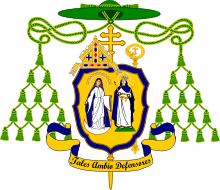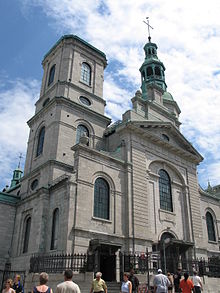Roman Catholic Archdiocese of Quebec
Archdiocese of Québec Archidioecesis Quebecensis Archidiocèse de Québec | |
|---|---|
 Coat of Arms of the Archdiocese of Québec | |
| Location | |
| Country | Canada |
| Territory | Quebec City |
| Ecclesiastical province | Quebec |
| Metropolitan | Quebec City, Quebec |
| Statistics | |
| Area | 35,180 km2 (13,580 sq mi) |
| Population - Total - Catholics | (as of 2010) 1,195,261 1,040,690 (87.1%) |
| Parishes | 219 |
| Information | |
| Denomination | Roman Catholic |
| Rite | Roman Rite |
| Established | 12 January 1658; 366 years ago |
| Cathedral | Notre-Dame de Québec Cathedral |
| Patron saint | St. Ann |
| Secular priests | 737 |
| Current leadership | |
| Pope | Francis |
| Archbishop | Gérald Lacroix |
| Auxiliary Bishops | Gaetan Proulx |
| Bishops emeritus | Maurice Couture |
| Website | |
| www | |

The Archdiocese of Québec (Template:Lang-la; French: Archidiocèse de Québec) is a Catholic archdiocese in Quebec, Canada. Being the first see in the New World north of Mexico, the Archdiocese of Québec is also the primatial see for Canada. The Archdiocese of Québec is also the ecclesiastical provincial for the dioceses of Chicoutimi, Sainte-Anne-de-la-Pocatière and Trois-Rivières. The archdiocese's cathedral is Notre-Dame de Québec Cathedral in Quebec City.
History
New France
From the beginning of colonisation of the New World, the Church influenced the politics and policies of New France. Even during the first voyages of Jacques Cartier in the 16th Century, missionary priests would accompany the explorers on their voyages to the New World. After two failed attempts to settle in Acadia, in 1608, Québec City was founded by Samuel de Champlain, giving the Church a solid base in which to spread the faith to the Indigenous populations. In 1615, the Recollet missionaries arrived in Québec, followed by the Jesuit missionaries 10 years later. Their presence would help drive the colonies, giving the colonizers a moral reason for their presence, as well as giving the Church an influential position in domestic and local policy. In 1658, the Church would establish an Apostolic Vicariate by Pope Alexander VII, 124 years since the first voyage of Jacques Cartier in 1534. The vicar apostolic was François de Laval. As The vicar apostolic of Québec, Laval was a central member of the Sovereign Council of New France. Arguably, while he was charged with only the spiritual matters of New France, he had the most influence as he was the highest representative of the Church, as well as having excellent relations with King Louis XIV. In 1663, Laval would establish the Seminary of Québec. In 1674, with the population of New France growing rapidly and the Seminary of Québec enrolling more students, Pope Clement X elevated the Apostolic Vicariate to a diocese, which would depend directly on the Holy See; this provision would later secure its permanence after New France passed into the hands of Great Britain in 1760. At its peak, in 1712, the Diocese of Québec covered the entire American continent to the Gulf of Mexico. Only the British colonies that would later become the United States and the Spanish colony of Florida was not under the authority of the Bishop of Quebec.
British Rule
Under British Rule, The peoples of Québec were discriminated against in respect of their Catholic faith and their language. Any person in the Empire wanting to take a position had to take the Test Oath which denounced their faith. Because almost all the colonists were French speaking Catholics, the Test Oath prevented the local population from participating in local politics. However, in 1774, the British Parliament passed the Quebec Act that allowed Québec to restore the use of French customary law ("Coutume de Paris") in private matters alongside the British common law system, and allowed the Church to collect tithes on Roman Catholics businesses and property. In 1819, the diocese was elevated to an archdiocese. By 1840, political leaders formally recognized the Church. The Archdiocese of Québec, which then covered the entire present-day Canada, was split into new dioceses as the population increased.
Today
It lost large pieces of its territory with the formation of the Dioceses of Halifax and Kingston in 1817, the Diocese of Charlottetown in 1829, the Diocese of St. Boniface in 1844 and the Diocese of Montréal in 1852.
It is common, but not inherent to the title, for the Archbishops of Québec to either be named to the cardinalate while serving or when transferred to a larger archdiocese or to a post in the Roman Curia.
Primate of Canada
Since 24 January 1956, the Archbishop of Québec has the ceremonial title of Primate of Canada; the title was given to the reigning Archbishop of Québec by the Venerable Servant of God Pope Pius XII.
Bishops
- Bishop François de Montmorency-Laval (1658–1688)
- Bishop Jean-Baptiste de la Croix de Chevrières de Saint-Vallier [1] (1688–1727)
- Bishop Louis-François Duplessis de Mornay (1727–1733)
- Bishop Pierre-Herman Dosquet (1733–1739)
- Bishop François-Louis de Pourroy de Lauberivière (1739–1740)
- Bishop Henri-Marie Dubreil de Pontbriand (1741–1760)
- Bishop Jean-Olivier Briand (1766–1784)
- Bishop Louis-Philippe Mariauchau d’Esgly (1784–1788)
- Bishop Jean-François Hubert (1788–1797)
- Bishop Pierre Denaut (1797–1806)
- Archbishop Joseph-Octave Plessis (1806–1825)
- Archbishop Bernard-Claude Panet (1825–1833)
- Archbishop Joseph Signay (1833–1850)
- Archbishop Pierre-Flavien Turgeon (1850–1867)
- Archbishop Charles-François Baillargeon (1855–1870) [2]
- Cardinal Elzéar-Alexandre Taschereau, Archbishop (1871–1898)
- Cardinal Louis Nazaire Bégin, Archbishop (1898–1925)
- Archbishop Paul-Eugène Roy (1925–1926)
- Cardinal Felix-Raymond-Marie Rouleau, Archbishop (1926–1931)
- Cardinal Jean-Marie-Rodrigue Villeneuve, Archbishop (1931–1947)
- Cardinal Maurice Roy, Archbishop (1947–1981)
- Cardinal Louis-Albert Vachon, Archbishop (1981–1990)
- Archbishop Maurice Couture (1990–2002)
- Cardinal Marc Ouellet, Archbishop (2002–2010)
- Cardinal Gérald Lacroix, Archbishop (2011–present)
Recent appointments
On February 22, 2011, Vatican Information Service (VIS) and Catholic News Service (CNS), announced that Pope Benedict XVI had named the 53-year-old Bishop Gérald Lacroix, until then an Auxiliary Bishop (assistant bishop) of Quebec (since 2009), as the new Metropolitan Archbishop of the Roman Catholic Archdiocese of Quebec and Primate of Canada. As archbishop, he succeeds Marc Ouellet, his former superior, who became the prefect of one of the Roman Curia's most important administrative departments, the Sacred Congregation for Bishops, in July 2010. Lacroix is a member of the Quebec-based Saint Pope Pius X Secular Institute. Lacroix was born in Saint-Hilaire-de-Dorset, Quebec, on July 27, 1957, the eldest son in a family of seven children. At the age of 8, his family settled in Manchester, New Hampshire's largest city, where he attended the parochial elementary school of Saint Anthony of Padua and Trinity High School. He studied one year at Saint Anselm College in neighboring Goffstown. He joined the Pius X Secular Institute as a consecrated lay member in 1975, and made perpetual vows in 1982. The same year, he was named secretary general of the institute. He earned a master's degree in pastoral theology at Laval University, and from 1985 to 1987, directed the La Maison du Renouveau, a formation and Christian renewal centre. He was ordained a priest on October 8, 1988, in the parish of Notre-Dame-de-la-Recouvrance. He was ordained to the episcopacy as Auxiliary Bishop of Quebec on May 24, 2009.
On December 12, 2011, Pope Benedict appointed Gaetan Proulx and Denis Grondin Jr. as Auxiliary Bishops-elect of the Archdiocese of Quebec to serve under Lacroix. They will be ordained to the episcopacy as Auxiliary Bishops of Quebec on February 25, 2012.[3]
